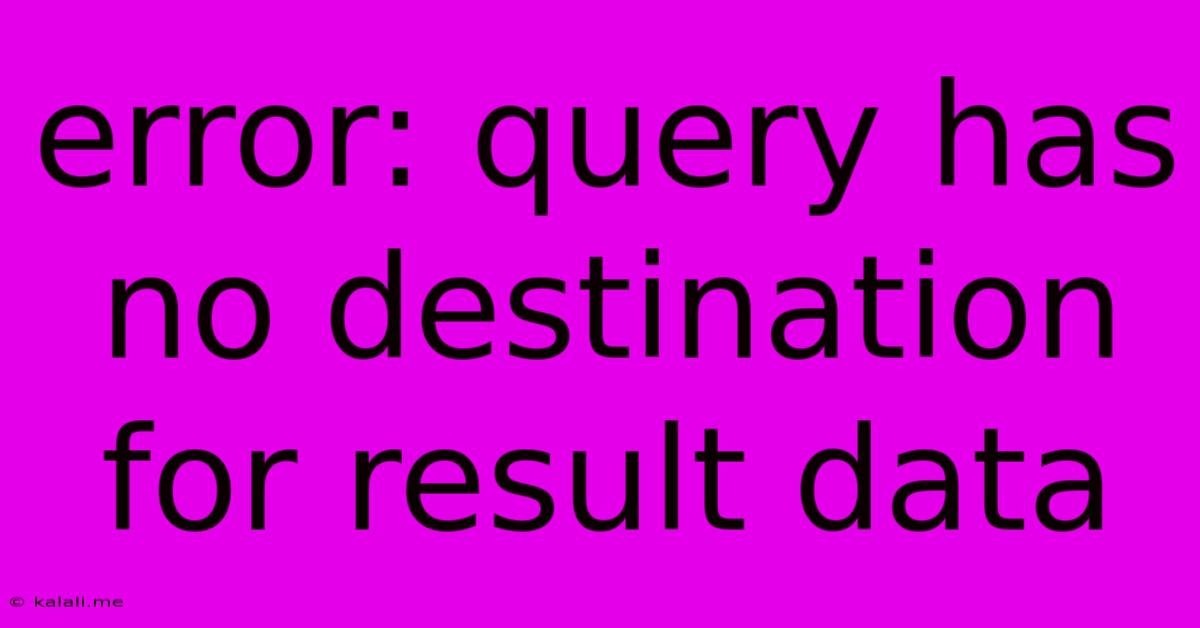Error: Query Has No Destination For Result Data
Kalali
Jun 01, 2025 · 4 min read

Table of Contents
Decoding the "Error: Query Has No Destination for Result Data" Message
This frustrating error message, "Error: Query has no destination for result data," pops up when your database query successfully executes but lacks a mechanism to store or display the resulting data. This article will dissect the root causes of this problem across various database systems and provide practical solutions for resolving it. Understanding this error is crucial for any developer working with SQL or similar database query languages.
This error often occurs in stored procedures, scripts, or applications interacting with databases like MySQL, PostgreSQL, SQL Server, or Oracle. The core issue remains consistent: your query produces a result set, but your code doesn't specify where that data should go.
Common Scenarios Leading to the Error
This error isn't tied to a specific database type but is a conceptual issue related to data handling. Here are some common culprits:
- Missing
INTOclause (for INSERT statements): When inserting data, you must specify the target table using theINTOclause. Forgetting this leads directly to the error. For example, the following query is incorrect:
INSERT INTO users (name, email) VALUES ('John Doe', '[email protected]'); --Correct
--Incorrect Example:
-- INSERT users (name, email) VALUES ('Jane Doe', '[email protected]');
The corrected query uses the INTO keyword to specify where the data should be inserted.
- Incorrect
SELECTstatement without a destination: ASELECTstatement without anINTOclause (in some systems) or a subsequent action (like printing to the console, populating a variable, or updating a table) will produce the error.
-- Incorrect: No destination for the SELECT results
SELECT * FROM products;
-- Correct: Using a variable to store the results (Example, language-specific)
SELECT * INTO @products FROM products;
-- Correct: Printing to the console (Example, language-specific)
print(SELECT * FROM products)
-- Correct: Using the result set in an update statement
UPDATE orders SET status = 'shipped' WHERE order_id IN (SELECT order_id FROM order_details WHERE product_id = 123)
-
Stored procedure issues: In stored procedures, if a
SELECTstatement is executed without assigning the result to an output parameter or using aCURSORto process the results, the error will occur. Ensure you are either returning data using anOUTparameter or processing results within the procedure using a cursor. -
Programming Language Integration Errors: The problem may not reside within the SQL query itself but in how the application interacts with the database. If you're using a programming language (like Python, PHP, Java, etc.) to execute your query, make sure you are correctly handling the result set returned by the database driver. Missing functions to fetch or process the query results will manifest as this error from the database's perspective.
Troubleshooting and Solutions
-
Review your query: Carefully examine your SQL query for missing
INTOclauses, incorrect syntax, or logical errors. Ensure the query is structurally sound and targets a valid table or variable. -
Check for syntax errors: Even small typos can lead to unexpected behavior. Double-check your SQL code for any syntax errors.
-
Verify table and column names: Confirm that the table and column names used in your query are accurate and exist in the database.
-
Examine the database connection: Make sure you have a valid connection to the database. Connection errors often manifest as this type of message because the query cannot even be executed properly, let alone store its results.
-
Test with a simple query: Try a basic
SELECTstatement to rule out issues with your database connection or the application's interaction with the database. -
Use debugging tools: Utilize your database system's debugging tools or your programming language's debugging capabilities to step through your code and identify the exact point where the error occurs. This allows for a more granular approach to identifying and resolving the issue.
-
Consult database documentation: Refer to your specific database system's documentation for details on handling query results and stored procedures. Each system has its own nuances.
By meticulously following these troubleshooting steps and understanding the underlying principles of data handling in database queries, you can effectively resolve the "Error: Query has no destination for result data" and ensure smooth data processing within your applications.
Latest Posts
Latest Posts
-
Why Am I Not Getting Notifications
Jun 03, 2025
-
Can You Pump A Car Tire With A Bike Pump
Jun 03, 2025
-
How To Save An Aloe Plant
Jun 03, 2025
-
Love The Lord You God With All Your Heart
Jun 03, 2025
-
How Do You Pluralize A Name That Ends In S
Jun 03, 2025
Related Post
Thank you for visiting our website which covers about Error: Query Has No Destination For Result Data . We hope the information provided has been useful to you. Feel free to contact us if you have any questions or need further assistance. See you next time and don't miss to bookmark.